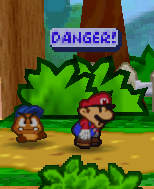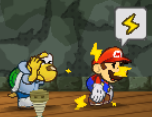Danger: Difference between revisions
Ace Shadow (talk | contribs) mNo edit summary |
Scrooge200 (talk | contribs) (I checked out SPM and the only danger indicator is the health bar flashing, which is impossible to capture in a single image, unlike the other games which have red flashes and/or a different idle. But I figured I'd include it for completion's sake) |
||
| (40 intermediate revisions by 22 users not shown) | |||
| Line 1: | Line 1: | ||
{{spotlight notice|completed=y}} | |||
[[File:PM64 Danger.png|thumb|Mario in Danger status.]] | [[File:PM64 Danger.png|thumb|Mario in Danger status.]] | ||
'''Danger''' is a status effect that appears in all [[Paper Mario (series)|''Paper Mario'' games]]. It occurs when [[Mario]]'s or any of his [[Partner]]'s [[HP]] | '''Danger''' is a status effect that appears in all [[Paper Mario (series)|''Paper Mario'' games]]. It occurs when [[Mario]]'s or any of his [[Partner]]'s [[Heart Point|HP]] reaches a specific low amount, causing a bubble with the words 'Danger' to appear above them. An alarm sound is also played on repeat to remind the player to use [[List of items|healing items]]. A similar status, [[Peril]], also appears alongside it. | ||
< | ==Appearances== | ||
[[Category: | ===''Paper Mario''=== | ||
[[Category:Paper Mario]] | In ''[[Paper Mario]]'', Danger is a status that automatically occurs when Mario’s HP is in the range of 2 to 5 points. If a character's HP reaches 1, however, Danger is overridden by the Peril status, which occurs with a similar, higher-pitched alarm playing. Several special [[badge]]s are activated, namely [[Power Rush]], [[Close Call (badge)|Close Call]], and [[Last Stand]] which will not lose their effect until the player is no longer in Danger. The player can allow Mario to always be in Danger by using [[Chet Rippo]] to lower his max HP to 5. By stacking [[Power Rush]] badges, Mario can do large amounts of damage to singular enemies. | ||
[[Category:Paper Mario: The Thousand-Year Door]] | |||
[[Category:Super Paper Mario]] | ===''Paper Mario: The Thousand-Year Door''=== | ||
[[Category:Paper Mario: | [[File:Mariokoopsdanger.png|frame|left]] | ||
The Danger status effect reappears in ''[[Paper Mario: The Thousand-Year Door]]''. In this game, the special badges reappear along with new partner-only counterparts, which are [[Power Rush P]], [[Close Call P]], and [[Last Stand P]]. The partner badges are exclusive to this game, as partners are now given their own HP unlike in ''Paper Mario''. These badges do not lose their effect when in Peril, and will actually stack with [[Mega Rush]] and [[Mega Rush P]], the only Peril-activated badges. Like in ''Paper Mario'', Mario and his partners can put themselves in Danger permanently by using Chet Rippo to lower their max HP. | |||
In ''Paper Mario: The Thousand-Year Door'', Mario can obtain a high amount of Power Rushes in the [[Pianta Parlor]] where they, or their P counterparts, can be bought for 34 [[pianta token]]s each. This allows Mario or his partner to do up to 99 damage per hit on any given enemy. | |||
{{br}} | |||
===''Super Paper Mario''=== | |||
Danger appears again in ''[[Super Paper Mario]]'', with a different criteria for activating. Instead of being activated by a character having 2-5 HP, it instead occurs when any given character has less than 20% of their max HP. As badges do not exist in this installment, Danger has no practical use other than to remind the player to heal themselves. | |||
===''Paper Mario: Sticker Star'' / ''Paper Mario: Color Splash'' / ''Paper Mario: The Origami King''=== | |||
{{rewrite|section=y|Split into separate sections}} | |||
Danger appears again in ''[[Paper Mario: Sticker Star]]'', and its sequels, ''[[Paper Mario: Color Splash]]'' and ''[[Paper Mario: The Origami King]]''. Unlike in past installments, an alarm for the status does not play. Instead, the battle music becomes off-key and sloppy. Similarly to ''Super Paper Mario'', it is activated when Mario has 30% or lower of his max HP. Unlike in past installments, enemies are also visibly affected when low on HP. Additionally, characters lose some of their color when in this state in ''Color Splash''. In ''The Origami King'', the name tag of the enemy is displayed in orange while they are in this state. | |||
==Gallery== | |||
<gallery> | |||
SPM Danger.png|Luigi in Danger in ''[[Super Paper Mario]]'' | |||
PMSS Danger.png|Mario in Danger in ''[[Paper Mario: Sticker Star]]'' | |||
PMCS Danger.png|Mario in Danger in ''[[Paper Mario: Color Splash]]'' | |||
PMTOK Danger.png|Mario in Danger in ''[[Paper Mario: The Origami King]]'' | |||
</gallery> | |||
==Names in other languages== | |||
{{foreign names | |||
|Jap=ピンチ | |||
|JapR=Pinchi | |||
|JapM=Pinch | |||
|ChiS=危险<ref>From [[iQue]]'s localization of ''[[Paper Mario]]'': https://www.youtube.com/watch?v=qj23Urolr1I (1:31:43)</ref> | |||
|ChiSR=Wēixiǎn | |||
|ChiSM=Danger | |||
}} | |||
==References== | |||
<references/> | |||
{{PM}} | |||
{{PMTTYD}} | |||
{{SPM}} | |||
{{PMSS}} | |||
{{PMCS}} | |||
{{PMTOK}} | |||
[[Category:Paper Mario status effects]] | |||
[[Category:Paper Mario: Sticker Star status effects]] | |||
[[Category:Paper Mario: The Thousand-Year Door status effects]] | |||
[[Category:Super Paper Mario status effects]] | |||
[[Category:Paper Mario: Color Splash status effects]] | |||
[[it:Pericolo]] | |||
Revision as of 02:08, April 21, 2024

|
This article has been chosen to be a focus for this month's edition of The 'Shroom Spotlight, and our goals have been completed. If there are further improvements that can be made, make them. |
Danger is a status effect that appears in all Paper Mario games. It occurs when Mario's or any of his Partner's HP reaches a specific low amount, causing a bubble with the words 'Danger' to appear above them. An alarm sound is also played on repeat to remind the player to use healing items. A similar status, Peril, also appears alongside it.
Appearances
Paper Mario
In Paper Mario, Danger is a status that automatically occurs when Mario’s HP is in the range of 2 to 5 points. If a character's HP reaches 1, however, Danger is overridden by the Peril status, which occurs with a similar, higher-pitched alarm playing. Several special badges are activated, namely Power Rush, Close Call, and Last Stand which will not lose their effect until the player is no longer in Danger. The player can allow Mario to always be in Danger by using Chet Rippo to lower his max HP to 5. By stacking Power Rush badges, Mario can do large amounts of damage to singular enemies.
Paper Mario: The Thousand-Year Door
The Danger status effect reappears in Paper Mario: The Thousand-Year Door. In this game, the special badges reappear along with new partner-only counterparts, which are Power Rush P, Close Call P, and Last Stand P. The partner badges are exclusive to this game, as partners are now given their own HP unlike in Paper Mario. These badges do not lose their effect when in Peril, and will actually stack with Mega Rush and Mega Rush P, the only Peril-activated badges. Like in Paper Mario, Mario and his partners can put themselves in Danger permanently by using Chet Rippo to lower their max HP.
In Paper Mario: The Thousand-Year Door, Mario can obtain a high amount of Power Rushes in the Pianta Parlor where they, or their P counterparts, can be bought for 34 pianta tokens each. This allows Mario or his partner to do up to 99 damage per hit on any given enemy.
Super Paper Mario
Danger appears again in Super Paper Mario, with a different criteria for activating. Instead of being activated by a character having 2-5 HP, it instead occurs when any given character has less than 20% of their max HP. As badges do not exist in this installment, Danger has no practical use other than to remind the player to heal themselves.
Paper Mario: Sticker Star / Paper Mario: Color Splash / Paper Mario: The Origami King
It has been requested that this section be rewritten. Reason: Split into separate sections
Danger appears again in Paper Mario: Sticker Star, and its sequels, Paper Mario: Color Splash and Paper Mario: The Origami King. Unlike in past installments, an alarm for the status does not play. Instead, the battle music becomes off-key and sloppy. Similarly to Super Paper Mario, it is activated when Mario has 30% or lower of his max HP. Unlike in past installments, enemies are also visibly affected when low on HP. Additionally, characters lose some of their color when in this state in Color Splash. In The Origami King, the name tag of the enemy is displayed in orange while they are in this state.
Gallery
Luigi in Danger in Super Paper Mario
Mario in Danger in Paper Mario: Sticker Star
Mario in Danger in Paper Mario: Color Splash
Mario in Danger in Paper Mario: The Origami King
Names in other languages
| Language | Name | Meaning |
|---|---|---|
| Japanese | ピンチ Pinchi |
Pinch |
| Chinese (simplified) | 危险[1] Wēixiǎn |
Danger |
References
- ^ From iQue's localization of Paper Mario: https://www.youtube.com/watch?v=qj23Urolr1I (1:31:43)





